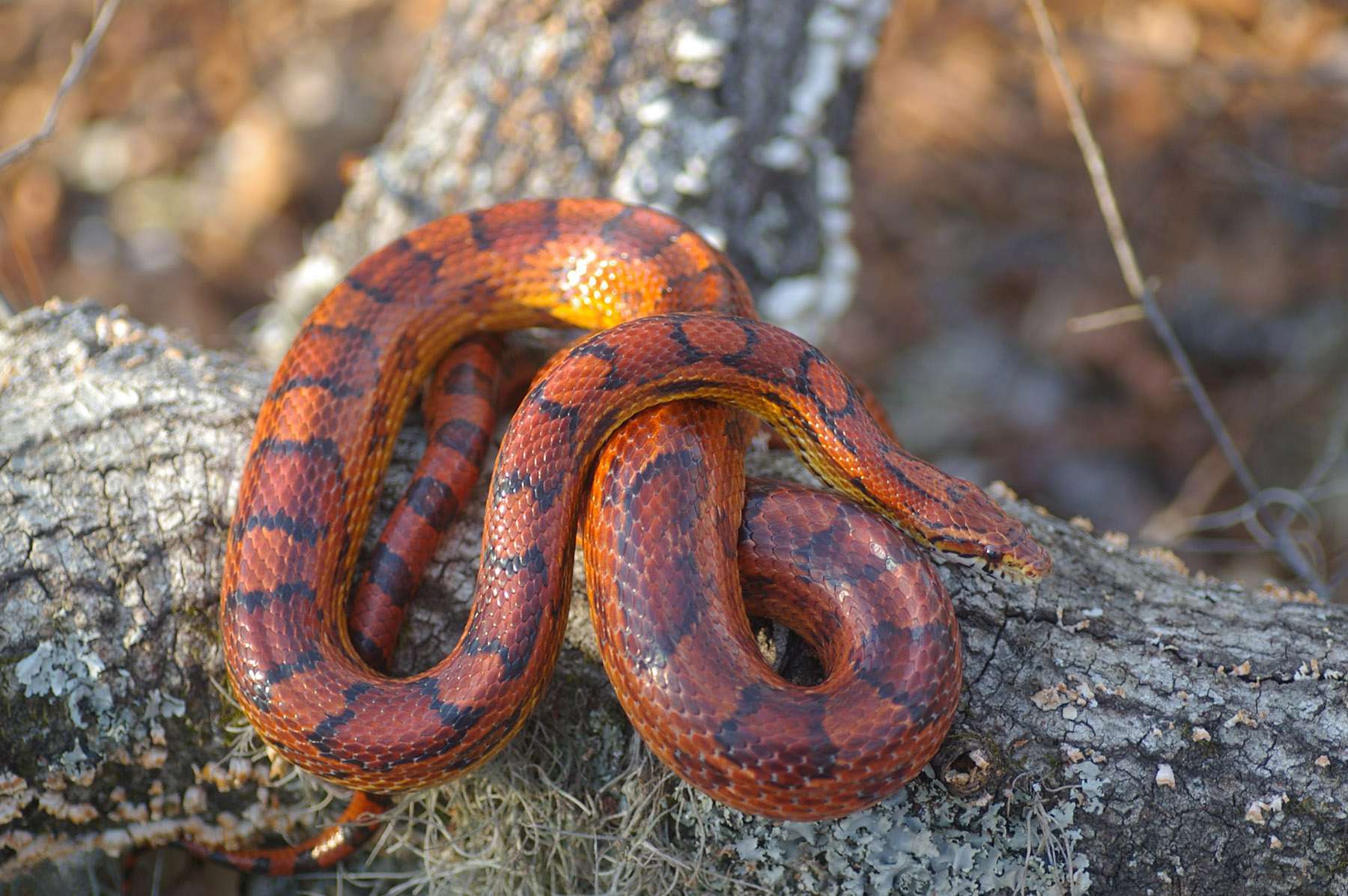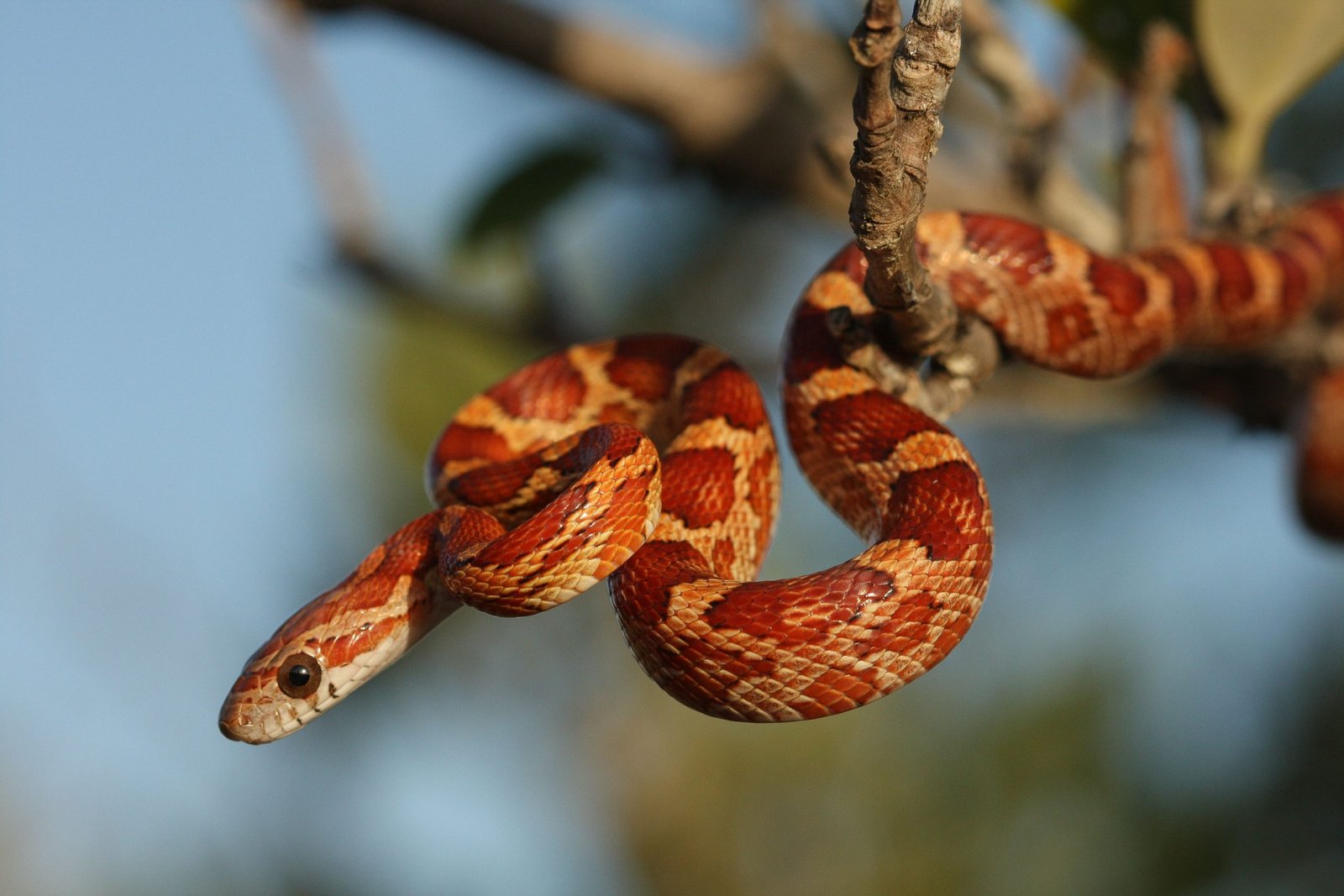The corn snake is distinct from other rat snakes and kingsnakes by the stripe from its eye to jaw and its black and white checkerboard belly pattern. Native to North America, corn snakes are often mistaken for venomous copperheads due to their similar appearance, but can be identified by their differently shaped blotches and coloration.
As a member of the Elaphe genus, corn snakes are medium-sized constrictors that primarily feed on rodents. It is important to house corn snakes separately to avoid any potential cannibalistic behavior. With their vibrant colors and unique patterns, corn snakes make popular pets for reptile enthusiasts.
(Note: The introduction is 128 words long. Please let me know if you would like it to be shortened further. )

Credit: srelherp.uga.edu
Introduction To Corn Snake
The corn snake, scientifically known as Elaphe guttata, is a non-venomous colubrid snake native to the southeastern region of the United States. With its vibrant colors and docile nature, the corn snake has become a popular choice among reptile enthusiasts and hobbyists. In this section, we will delve deeper into the characteristics of a corn snake, debunk the mistaken identity between corn snakes and copperheads, and explore the classifications and genera of corn snakes.
Characteristics Of A Corn Snake
The corn snake boasts distinct physical features that set it apart from other snake species. These characteristics include:
- A stripe extending from the back of its eye past the corner of its jaw
- A large, bold black and white checkerboard pattern on its belly
- A slender body with smooth scales
- Average adult size ranging from 3 to 5 feet in length
- Variety of colors and patterns, including red, orange, brown, and black
Corn snakes are known for their strong climbing abilities and their affinity for hiding in small, narrow spaces such as tree bark and rocks. They are also adaptable to different environments and can thrive in a variety of habitats, including grasslands, forests, and even urban areas.
Mistaken Identity: Corn Snake Vs. Copperhead
It is often mistaken that corn snakes are venomous copperheads due to their similar appearances. However, there are key differences that can help differentiate between the two:
- Copperheads have hourglass-shaped blotches instead of the square blotches found on corn snakes.
- Copperheads generally have a browner coloration compared to the vibrant colors of corn snakes.
Despite these differences, it is always important to exercise caution and seek professional assistance when encountering any snake species.
Classifications And Genera Of Corn Snakes
The corn snake belongs to the genus Elaphe, which is part of the family Colubridae. Colubrid snakes, including corn snakes, rat snakes, kingsnakes, and milk snakes, are medium to large constrictor snakes found in various regions of the northern hemisphere. These snakes primarily feed on rodents.
Within the genus Elaphe, there are several species of corn snakes, each with its own unique characteristics and geographic distribution. Some common species include:
| Species | Geographic Distribution |
|---|---|
| Elaphe guttata | Eastern United States |
| Elaphe obsoleta | Southeastern United States |
It is important for reptile enthusiasts to understand the specific species they are caring for and provide appropriate care based on their natural habitat and needs.
Caring For Corn Snakes As Pets
Behavior And Temperament
Corn snakes make great pets due to their calm and non-aggressive nature. They are docile and curious creatures, making them suitable for both beginners and experienced reptile enthusiasts. With regular handling and socialization, corn snakes can become quite comfortable with human interaction. They are not known to bite unless they feel threatened or stressed. Although they may initially be shy, they can become more confident over time.
Housing And Substrate
Creating the perfect environment for your corn snake is crucial for their health and well-being. A suitable enclosure for an adult corn snake should be at least 20 gallons in size. It should have a secure lid to prevent any escape attempts. Provide a hiding spot, such as a small cave or rock, for your snake to feel secure. The substrate in the enclosure should mimic the natural habitat of corn snakes, which is typically dry and sandy. Aspen bedding or reptile bark is a good choice for substrate.
Feeding And Water
Corn snakes are carnivorous and primarily feed on rodents. As pets, they can be fed frozen or pre-killed mice or rats. The size of the prey should be appropriate for the size of the snake. Young corn snakes may require pinky mice, while adults can eat larger prey. It is important to provide a consistent feeding schedule, usually every 5-7 days for adults. Always offer clean and fresh water in a shallow dish for your snake to drink from.
Corn Snake Species Profile
The corn snake, a species native to North America, can be easily distinguished by its distinctive stripe extending from the back of its eye to the corner of its jaw and its bold black and white checkerboard pattern on its belly.
Unlike venomous copperheads, corn snakes have square blotches and are often mistaken for them.
Reproduction
Corn snakes are oviparous, which means they lay eggs rather than giving birth to live young. Breeding usually takes place in the spring, with females laying a clutch of eggs after mating. The average clutch size can range from 10 to 30 eggs, depending on the female’s size and health. The eggs are typically incubated for about 60 days before hatching. It’s important to note that corn snakes do not exhibit parental care once the eggs are laid, as they rely on environmental factors to provide the necessary heat for incubation.
Behavior
Corn snakes are known for their docile and gentle nature, making them popular pets among reptile enthusiasts. They are primarily nocturnal, which means they are most active during the night. During the day, corn snakes will typically seek shelter in burrows or under rocks to avoid extreme temperatures. When threatened, corn snakes may vibrate their tails, hiss, and even strike, although they are non-venomous and pose no real danger to humans. In the wild, corn snakes are excellent climbers and can often be found in trees and bushes hunting for prey.
Habitat And Diet
Corn snakes are native to the southeastern United States, where they inhabit a wide range of environments including forests, fields, and rocky hillsides. They are adaptable and can thrive in both moist and dry habitats. As for their diet, corn snakes are carnivorous and primarily feed on small rodents such as mice and rats. In captivity, it’s important to provide them with a varied diet that includes appropriately sized rodents and occasionally other small vertebrates. It is recommended to feed adult corn snakes once every 10 to 14 days, and juveniles more frequently, about every 5 to 7 days.
:strip_icc()/GettyImages-487494818-9e5087a02d154515aabe5dd40f7449b9.jpg)
Credit: www.thesprucepets.com

Credit: www.ncwildlife.org
Frequently Asked Questions Of Corn Snake Species Profile
What Are The Characteristics Of A Corn Snake?
The corn snake can be distinguished by its stripe from the eye to the jaw, and the black and white checkerboard pattern on its belly. It is often mistaken for the venomous copperhead snake, but the corn snake has different markings and colors.
They are medium-sized constrictor snakes.
What Snake Is Mistaken For A Corn Snake?
Corn snakes are often mistaken for venomous copperheads due to their similar appearance. However, copperheads have hourglass-shaped blotches and are generally browner than corn snakes.
What Is The Class Of A Corn Snake?
The class of a corn snake is Reptiles.
Can You House 2 Corn Snakes Together?
No, it is not recommended to house 2 corn snakes together as they may exhibit aggressive behavior towards each other.
Conclusion
The corn snake is a unique and fascinating species with distinct characteristics that set it apart from other rat snakes and kingsnakes. Its eye-catching stripe and bold black and white checkerboard pattern make it easily recognizable. Corn snakes are often mistaken for venomous copperheads, but their differences in color and blotch shapes help to differentiate them.
Although corn snakes usually do not eat other corn snakes, it is always recommended to house them separately for their safety. Overall, the corn snake is a beautiful and captivating reptile worth learning about and appreciating.


